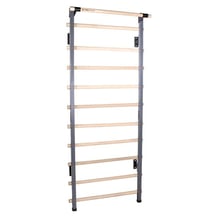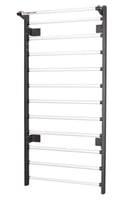
A common recommendation for treating sore muscles or back pain is to stretch. Whether afflicted with scoliosis, frequently spend nights sleeping in an odd position, or struggle with the
task of tying your shoes, the discomfort of back pain can be frustrating and limiting. While CrossFit Journal describes the beneficial use of stall bars for active individuals, it also notes its therapeutic abilities (Harmsen, 2006). With this in mind, we would like to highlight three of the stall/chin-up bars that we offer, and how they meet each type of need.
 To begin, we’d like to bring attention to the Core Series: Adjustable Stall/Swedish Wall Bars. Its name appears to be inspired by Per Henrik Ling, a Swedish man who was one of the individuals responsible for the stall bar’s inception (Harmsen, 2006). For this particular model, the chin-up feature, adjustable bar heights and price point are three of its most appealing qualities. However, this model does not offer much space between the ladder and the wall, inhibiting movement for some exercises pertaining to physical therapy (“Schroth Stall Bars”). Of the three, this option is not the most conducive to those who are using it for its therapeutic purposes. However, when used for fitness, this is a highly beneficial model to invest in.
To begin, we’d like to bring attention to the Core Series: Adjustable Stall/Swedish Wall Bars. Its name appears to be inspired by Per Henrik Ling, a Swedish man who was one of the individuals responsible for the stall bar’s inception (Harmsen, 2006). For this particular model, the chin-up feature, adjustable bar heights and price point are three of its most appealing qualities. However, this model does not offer much space between the ladder and the wall, inhibiting movement for some exercises pertaining to physical therapy (“Schroth Stall Bars”). Of the three, this option is not the most conducive to those who are using it for its therapeutic purposes. However, when used for fitness, this is a highly beneficial model to invest in.

With the stall bar's remedial abilities in mind, we would like to highlight the Restore Series: ‘Schroth Method’ Therapy Stall Bars/Swedish Bars. According to John Hopkins Medicine, scoliosis patients not only use this type of equipment for pain management, but also for preventative strength training. Possessing the ability to support up to 500 pounds, standing approximately five inches away from the wall, and able to provide up to eight inches of leeway between the ladder and offset top rung, the inclusivity of this product is a major selling point. Informed by Katharina Schroth, a scoliosis patient and the originator of the Schroth Method (John Hopkins Medicine), designers were made aware of the modifications necessary to accommodate these particular needs.
 Lastly, we would like to note the benefits of the Extreme Series: 42" Stall Bars/Swedish Bars. The best of both worlds, this product combines the flexibility of the Core Series: Adjustable Stall Bars with the reliability of the Restore Series: ‘Schroth Method’ Stall Bars. Able to support up to 600 pounds and generously supplying the space needed for a variety of uses, this product provides the same therapeutic uses as the Restore Series: "Schroth Method" Stall Bars. Featuring a chin-up that is adjustable in height, this product is also an excellent choice for those interested in the fitness capabilities provided by the Core Series: Adjustable Stall Bars.
Lastly, we would like to note the benefits of the Extreme Series: 42" Stall Bars/Swedish Bars. The best of both worlds, this product combines the flexibility of the Core Series: Adjustable Stall Bars with the reliability of the Restore Series: ‘Schroth Method’ Stall Bars. Able to support up to 600 pounds and generously supplying the space needed for a variety of uses, this product provides the same therapeutic uses as the Restore Series: "Schroth Method" Stall Bars. Featuring a chin-up that is adjustable in height, this product is also an excellent choice for those interested in the fitness capabilities provided by the Core Series: Adjustable Stall Bars.
Whether interested in fitness, physical therapy, or both, we have something to offer each client.
Always made of durable materials and tested for quality, we are confident that each investment
in a stall bar will enhance your physical health and prevent issues from arising down the road.
Works Cited
Harmsen, Larry. “History and Use of Stall Bars.” CrossFit Journal, no. 44, 6 Apr. 2006,
journal.crossfit.com/2006/04/history-and-use-of-stall-bars.tpl#featureArticleTitle.
“Schroth Method for Scoliosis.” Johns Hopkins Medicine, John Hopkins Medicine,
www.hopkinsmedicine.org/health/conditions-and-diseases/scoliosis/schroth-method-for-
scoliosis
“Schroth Stall Bars.” Equilibrium Physical Therapy, Equilibrium Physical Therapy,
equilibriumpt.com/schroth-stall-bars/.
.png)
